
Hypericum is a genus of flowering plants in the family Hypericaceae. The genus has a nearly worldwide distribution, missing only from tropical lowlands, deserts and polar regions. Many Hypericum species are regarded as invasive species and noxious weeds. All members of the genus may be referred to as St. John's wort, and some are known as goatweed. The white or pink flowered marsh St. John's worts of North America and eastern Asia are generally accepted as belonging to the separate genus TriadenumRaf.

Hypericum androsaemum, the shrubby St. John's wort, is a flowering plant in the family Hypericaceae. Commonly called tutsan or sweet-amber, the species is cultivated as an ornamental plant because of its striking red-tinted foliage, bright yellow petals, and its large clusters of fruit. Cultivars like 'Albury Purple' and 'Golden Tutsan' which have leaves with more pronounced purple and golden coloring, respectively.

Hypericum aegypticum is a species of flowering plant of the St. John's wort family (Hypericaceae) which is native to the Eastern Mediterranean. It was described by Carl Linnaeus in the second volume of his Species Plantarum in 1753, who named it after Egypt despite it not being distributed there. The plant is commonly known as shrubby St. John's wort or Egyptian St. John's wort in English. Like other members of section Adenotrias, it is found among limestone rocks in coastal areas. While it has been evaluated as threatened on the island of Malta, the species has no legal protections.

Hypericum bupleuroides is a species of perennial flowering plant in the St John's wort family, Hypericaceae. It grows 45–80 centimeters tall, and notably has perfoliate leaves that are fused at the stem. It has pyramid-shaped flower clusters of 1 to 25 flowers with yellow petals in a star-shaped arrangement. The species is found along the Black Sea coast near the Turkish–Georgian border. Hypericum bupleuroides has a small distribution and specific habitat requirements that make it vulnerable to environmental pressures.
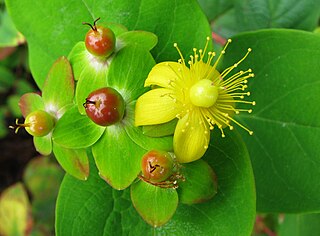
Androsaemum, commonly called tutsan, is a section of flowering plants in the family Hypericaceae. It is made up of Hypericum androsaemum, H. foliosum, H. grandifolium, and H. hircinum, as well as the hybrid H. × inodorum. When it was first described, it was considered its own independent genus, but was later placed under Hypericum and demoted to a section. It is also the namesake of an "Androsaemum-group" of related taxa that includes several other sections of Old World species. The Latin name Androsaemum comes from a Greek work to describe plants with red sap, and literally means "blood-man".

Hypericum foliosum, the shining St John's wort, is a species of flowering plant in the family Hypericaceae. It is a bushy shrub endemic to the Portuguese Azores Islands with golden yellow petals and many stems. The species was described by William Aiton in 1789 and was later placed into section Androsaemum of the genus Hypericum by Norman Robson in 1984. It has a diverse essential oil profile made up mostly of monoterpene hydrocarbons, and significant concentrations of various medicinally useful phenols and carotenoids. Populations of the plant are small in number, but quick to colonize cleared areas like groves, landslide areas, and volcanic ash deposits. It is parasitized by fungus and by moth species, but is not considered endangered by the IUCN. H. foliosum is used in traditional medicine on the Azores for diuretic, hepatoprotective, and antihypertensive purposes. It also has in vitro antibiotic and antioxidizing capabilities.

Hypericum punctatum, the spotted St. John's wort, is a perennial herb native to North America. The yellow-flowered herb occurs throughout eastern North America into southern Canada. The process of microsporogenesis carried out by this plant is prone to errors in chromosomal segregation. It has a diploid number of 14 or 16. Insects are attracted to the plant's pollen and the hypericin in the plant's leaves is toxic to mammals.
Hypericum cuisinii is a perennial herb in the genus Hypericum, in the section Adenosepalum. The herb has pale yellow flowers and occurs in Greece and Turkey.
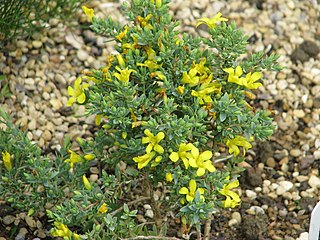
Adenotrias is a section of flowering plants in the family Hypericaceae. It is made up of Hypericum aciferum, H. aegypticum, and H. russeggeri. When it was first described, it was considered its own independent genus, but was later placed under Hypericum and demoted to a section. Its Latin name Adenotrias is made of the Greek prefix adeno- and the Latin word trias. Species in the section are shrubs up to 2 metres (6.6 ft) tall with smooth leaves and bark, and are the only species in Hypericum with heterostylous flowers. They are found around the Mediterranean coast, with H. aciferum restricted to the island of Crete and H. russeggeri present only in parts of Turkey and Syria. Plants of the section have a habitat among limestone and other calcareous rocks. While H. aegypticum has a wide and generally secure distribution, H. aciferum was evaluated as endangered several times since the 1980s, although it is now considered only vulnerable because it is protected in part by a plant micro-reserve near Agia Roumeli.

Hypericum undulatum, the wavy St Johns Wort, is a herbaceous perennial flowering plant native to western Europe and northern Africa. The specific name undulatum is Latin, meaning "wavy" or "undulated", referring, just as the common name, to the wavy leaf margins of the herb. The plant has a diploid number of 16 or 32.

Hypericum sechmenii, or Seçmen's St John's wort, is a rare species of flowering plant of the St John's wort family (Hypericaceae) that is found in the Eskişehir Province of central Turkey. It was first described in 2009 by Turkish botanists Atila Ocak and Onur Koyuncu, who named the species in honor of Özcan Seçmen, a fellow botanist. They assigned the species to the genus Hypericum, and Norman Robson later placed H. sechmenii into the section Adenosepalum.

Hypericum formosissimum is a species of flowering plant in the St John's wort family Hypericaceae. Found in the cracks of limestone rocks, it is a small perennial herb that grows in a pillow-like shape, has yellow flower petals, and blooms in the late summer. The plant is rare and has a limited habitat in Turkey, Armenia, and Azerbaijan. It is threatened by rock collapses, urbanization, and road construction; it is not protected by conservation efforts.

Hypericum huber-morathii is a species of flowering plant in the St John's wort family Hypericaceae. It is a small perennial herb with few stems. It has narrow and brittle stems, thick leaves, flowers in clusters of varying numbers, small yellow petals, around twenty stamens, and three styles. H. huber-morathii is closely related to H. minutum and H. sechmenii, and also shares characteristics with H. lanuginosum. The plant is endemic to Turkey, and is found among limestone rocks in a limited region of southwestern Anatolia. Originally excluded from a comprehensive monograph of Hypericum, the species' placement within the genus is unclear. It has been placed in both section Adenosepalum and section Origanifolium.

Hypericum russeggeri is a species of flowering plant in the St John's wort family Hypericaceae. The plant is a small shrub with many branches that spread across the ground, and it has many small flowers with pale yellow petals. It is found only among calcareous rocks along the coast and in the foothills of the Nur Mountains of eastern Turkey and northern Syria. While H. russeggeri has an array of phytochemicals present in its flowering structures and leaves, these are found in lower concentrations than other species of Hypericum. The species was first described in 1842 as Triadenia russeggeri, and it has been placed into various defunct genera including Elodea and Adenotrias. It is now known as Hypericum russeggeri and is the type species of Hypericum section Adenotrias, a small section that also includes H. aegypticum and H. aciferum.
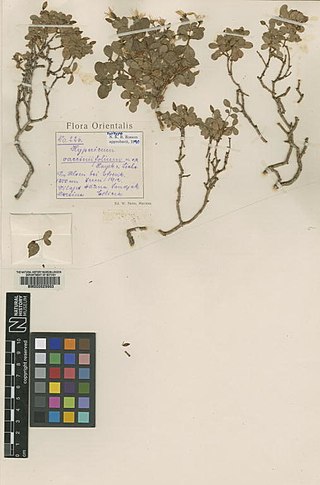
Hypericum vacciniifolium is a species of flowering plant in the flowering plant family Hypericaceae. It was first described by August von Hayek and Walter Siehe in the Ann. K. K. Naturhist. Hofmus. journal in 1914 from a specimen collected by Siehe in 1912.

Hypericum heterophyllum is a flowering plant in the Hypericaceae family and is the only species in Hypericum sect. Heterophylla.
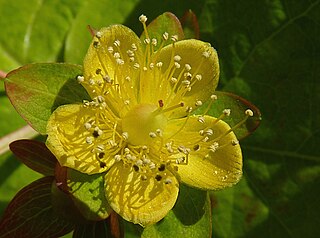
Hypericum × inodorum, called tall tutsan or the tall St John's wort, is a bushy perennial shrub with yellow flowers native to Western Europe. It has been known since 1789, but confusion around its name, identity, and origin persisted throughout the 19th and 20th centuries.
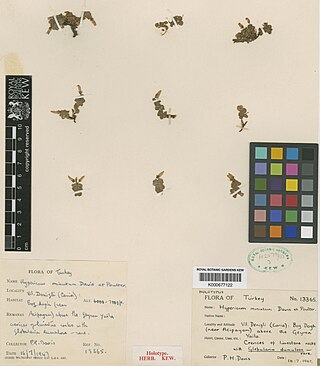
Hypericum minutum is a species of flowering plant in the St John's wort family Hypericaceae. It is a small perennial herb that grows in tufts. It has slender and brittle stems, flowers in clusters of one to three, yellow petals with black and amber glands, few stamens, and a seed capsule with narrow grooves. H. minutum is closely related to H. huber-morathii and H. sechmenii and resembles a smaller form of the latter plant. The plant is endemic to Turkey, and is found among limestone rocks in a limited region of southwestern Anatolia. Originally excluded from a comprehensive monograph of Hypericum, the species' placement within the genus is unclear. It has been placed in both section Adenosepalum and section Origanifolium.
Hypericum matudae is a species of flowering plant of the St. John's wort family Hypericaceae. It is a shrub that grows about 2 meters tall, has small and crowded branches, and has pink or white petals. Described in 1944 and named for botanist Eizi Matuda, the species was at one point named Thornea matudae because of its placement in the small genus Thornea. It was returned to Hypericum when Thornea was demoted to sectional status in 2016. Native to Nicaragua and Mexico, the species is found on shale and sandstone in the cloud forest ecosystem.


















